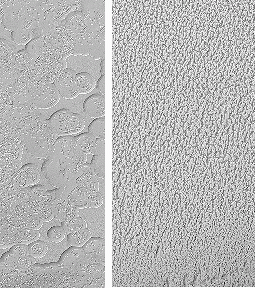Difference between Martian poles is the 'cheese,' Cornell researcher Peter Thomas and colleagues discover
By David Brand
New high-resolution images from NASA's Mars Global Surveyor spacecraft comparing the ice caps at the red planet's north and south poles show the difference between the two regions is the "cheese." The north polar cap has a relatively flat, pitted surface that resembles cottage cheese, while the south polar cap has larger pits, troughs and flat mesas that give it a Swiss cheese appearance.
"Looking like pieces of sliced and broken Swiss cheese, the upper layer of the Martian south polar residual cap has been eroded, leaving flat-topped mesas into which are set circular depressions," says Peter Thomas, a senior researcher with Cornell University's astronomy department and lead author of a paper published today (March 9) in the journal Nature. "Nothing like this has ever been seen anywhere on Mars except within the south polar cap, leading to some speculation that these landforms may have something to do with the carbon dioxide thought to be frozen in the south polar region," says Thomas.
In the Nature paper, Thomas and nine other members of the Mars Global Surveyor imaging team describe some of the newly discovered differences in polar terrain. "The unusual shapes of the landforms on the north and south polar caps suggest that these regions have had different climates and histories for thousands or perhaps even millions of years," says Thomas. "We are discovering them for the first time because Mars Global Surveyor is working to provide high-resolution views of the tremendously diverse terrain on Mars over all Martian seasons."
Andrew Ingersoll of the California Institute of Technology, Pasadena, Calif., another of the authors of the paper, notes, "These landforms may be telling us what the south polar cap is made of. The north residual cap -- the part that survives the summer -- is made of water ice. The south residual cap seems to be made of carbon dioxide or dry ice, but we don't know if this is a veneer a few meters thick or a solid block that extends down 2 or 3 kilometers (1.24 or 1.86 miles). These images may help us decide."
The north polar cap is covered mainly by pits, cracks, small bumps and knobs that give it a cottage cheese look. The pits that have developed on the surface are spaced close together relative to the very different depressions in the south polar cap. These pits probably developed slowly over successive spring and summer seasons.
"The polar images demonstrate again that understanding Mars' complicated history requires studying many areas in detail, just as understanding the Earth does," Thomas says.
Explains Ingersoll, "If we discovered that both polar caps are mostly water, it would leave a mystery about why there is so little carbon dioxide on Mars. Earth has a lot of carbon dioxide, but creatures living in the ocean have turned it into limestone rocks. Without oceans or life, Mars should have a lot more carbon dioxide on its surface than we seem to be finding."
Other authors of the Nature paper, titled "North-south geological differences between the residual polar caps on Mars," are Joseph Veverka and Robert Sullivan of Cornell's astronomy department; Michael Malin and K.S. Edgett of Malin Space Science Systems; M.H. Carr and L.A. Soderblom of the U.S. Geological Survey; W.K. Hartmann of the Planetary Science Institute; and P.B. James of the University of Toledo, Ohio.
Mars Global Surveyor is managed by the Jet Propulsion Laboratory (JPL) for NASA's Office of Space Science. JPL's industrial partner is Lockheed Martin Astronautics, which developed and operates the spacecraft. JPL is a division of Caltech.
Media Contact
Get Cornell news delivered right to your inbox.
Subscribe